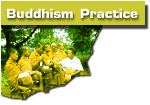 |
BANGKOK
|
||||||||
CENTRAL
|
||||||||||||
NORTHEASTERN
|
||||||||||||||
NORTHERN
|
||||||||||||
SOUTHERN
|
||||
 |
| A GUIDE TO MEDITATION CENTRES IN THAILAND |
| SOUTHERN - WAT KOW TAHM INTERNATIONAL MEDITATION CENTER |
 |
|
MEANING
OF NAME : |
"Mountain cave monastery" |
ALSO
SPELLED : |
Wat Kow Tahm |
ADDRESS
: |
International Meditation Center, Wat Kow Tahm, Bantai, Koh Pah-Ngan, Surat-thani 08280 Postal address: PO Box 18, Tong Sala Post Office, Koh Pah-Ngan, Surat-thani 08280
|
WEBSITE
: |
http://www.watkowtahm.org/ |
DIRECTIONS
: |
Koh Pha-Ngan, an idyllic island with many beaches, lies just north of Koh Samui in the Gulf of Thailand. Daily boats connect the islands with each other and direct to ferry terminals in the Surat Thani area. Bangkok Airways has daily flights between Bangkok and Koh Samui. Surat Thani has good bus, train, and air connections with Bangkok and other centers. On arrival at the pier in Thong Sala on Koh Pha-Ngan, take a songtaew or taxi southeast 4 km to the junction for Wat Kow Tham, then turn inland 1 km up a steep road to the wat. |
MEDITATION
SYSTEM : |
Vipassana similar to techniques taught by Mahasi Sayadaw. Primary concentration development is on the breathing and physical sensations; mental noting helps focus on moment to moment awareness. Teachers emphasize compassion as the basis of mental development and meditation practice. Compassion and loving kindness have a close connection and receive much attention. Standing meditation is taught as a formal practice along with sitting and walking postures. Wise reflections are encouraged on compassion-loving kindness, sympathetic joy, how fortunate we are, karma, death, dukkha, and impermanence. |
TEACHING
METHOD : |
During 10-day retreats, scheduled most months, teachers present a short Dhamma talk in the morning and a longer one in the evening. Further instructions are given during individual interviews. The teachers are often available for guidance between retreats too. The retreat talks can be purchased in a book and on audio tapes; people have found this material useful as an introduction before attending a retreat and a review afterward. |
TEACHERS
: |
Steve
Weissman (American; age 42) Rosemary Weissman (Australian; age 39) |
LANGUAGE
: |
English; some German material is available. Teachers also speak Thai. |
DESCRIPTION
: |
Beautiful island setting near the south coast. The wat covers 33 rai (13 acres) on a wooded hill; you can gaze out across the water to Koh Samui and other islands. |
SIZE
: |
monks
2-5 novices usually 0 nuns 4-6 laypeople Steve and Rosemary Weissman are resident |
DAILY
ROUTINE : |
The
day begins at 4 a.m. and is largely devoted to periods of (ON RETREAT)
sitting, walking, and standing meditation. A morning exercise session aids in developing mindfulness of body and improving flexibility. Teachers give morning and evening talks. Everyone is expected to keep noble silence and to follow the schedule. |
FOOD
: |
Wholesome Thai vegetarian. The kitchen serves 2 meals in the morning. A light dinner in the afternoon is also available during retreats; hot drinks are served in the afternoon between retreats. Some nonvegetarian food may be served between retreats. |
ACCOMMODATIONS
: |
Simple dormitories and some shared rooms; Thai-style bathrooms have running water. Buildings have electricity. |
WRITE
IN ADVANCE : |
A good idea to obtain retreat dates and registration information. Also, the wat closes occasionally when monastic retreats take place. Mail can be slow and unreliable, so it's best to visit in person in advance of your intended stay. |
OTHER
INFORMATION : |
Ten-day
intensive retreats take place most months. They usually begin about
midmonth (dates vary). The 40- person retreat capacity sometimes fills,
so it's a good idea to preregister by mail or in person. A 90 baht
(US $3.60) daily fee covers food expenses. Teaching and monastery
facilities are offered freely. Visitors are usually welcome to practice meditation here between retreats too. A simplified schedule is followed with more freedom for one to organize one's own time. Teachers may not beavailable, however. Note that the wat closes occasionally. Two new programs have been developed for approved old students an intensive 20-day retreat and a less- intensive 3-month work retreat scholarship; both are designed to help the student understand more fully how to incorporate their formal practice into their normal life. Much of the teaching centers on further development of yoniso manasikara (wise reflection) in developing Right Understanding and Right Intention. Attention is also given to the 10 paramis (perfections) and the 8 worldly conditions so that one can understand more clearly the difference between beneficial conditioning and unbeneficial conditioning. A Thai nun, Maechee Ah Mohn Pahn, is in charge of the center (nuns rarely have such a position in Thailand). She speaks English but does not teach the foreigners. |
| Select here : |
|
|